13 Best Natural Attractions in South Africa

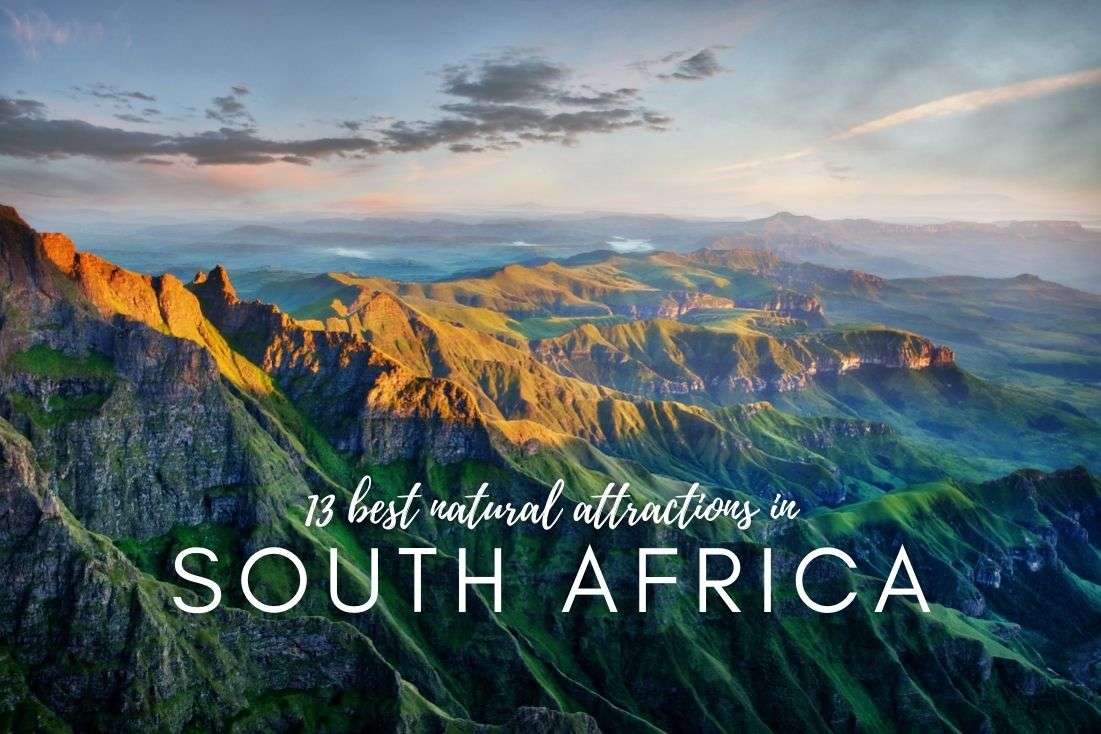
The diversity and volume of the country's natural beauty in South Africa is why you need—no joke—8 weeks to properly see all it has to offer (over several visits, I’d assume). The sheer spectrum of natural wonders is astounding—you can’t throw a rock without hitting some kind of spectacular mountain, insane viewpoint, or a slice of coast that looks too good to be true.
The contrast between the country's arid deserts and lush, green regions highlights its incredible ecological diversity.
And you know I’m not the type of person to exaggerate; if anything, I’m a sceptic through and through, and impressing me is quite a feat. But the nature in South Africa is unreal!
In this article, I’ll show you 14 of the most beautiful nature spots in South Africa. Some of these places, like Cape Town and Garden Route, are easy to reach. Others, like Drakensberg and Panorama Route, require a bit more effort. But if you can cram them all into your itinerary, I promise you’ll still be flabbergasted long after you return to your desk back home.
You could also be interested in reading:
- 2 Week + 3 Week South Africa Itineraries for Adventurous Travelers
- 23 Unpretentious Luxury Hotels in South Africa
- 30 FAQs and Tips for Planning Your Kruger Safari Visit
- 9 Epic Day Hikes on the Garden Route
- Cape Town Itineraries: Your Trip Plan for 3, 4, and 5 days
Once you’re ready to go, see the best hotels in South Africa and start booking that trip!
Here’s my list of the best natural wonders in South Africa:
- Cape of Good Hope
- Blyde River Canyon
- Tsitsikamma National Park and Storm River Mouth
- Table National Park
- Kruger National Park
- Drakensberg and Tugela Falls Hike
- Lions Head
- Bourkes Luck Potholes
- Kirstenbosch National Garden
- Wilderness National Park
- Panorama Route Waterfalls
- Sudwala Caves
- Cape Agulhas
1. Cape of Good Hope
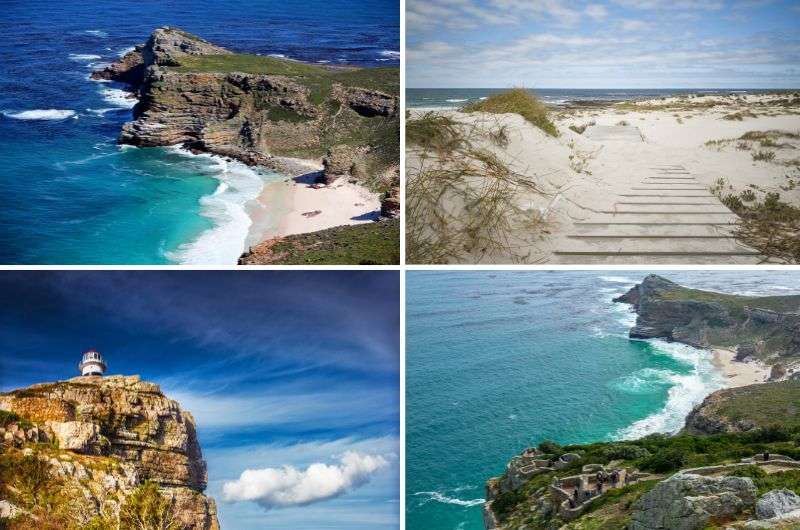
Diaz Beach is just one of the many beautiful natural wonders in the Cape of Good Hope
Even after two extended South Africa trips under my belt with extensive hiking exploration, I’m sticking to the Cape of Good Hope as my favorite hike and best natural wonder in South Africa. Let me tell you, nature turned up the dial to max awesomeness at Cape of Good Hope.
Fun Fact: The Cape of Good Hope is part of the Good Hope Nature Reserve, a protected area known for its rugged scenery and unspoiled wildlife.
The entire park is a treasure trove of amazing scenery and cool critters—just beware that those baboons might be cute, but they've got a mean bite! And don’t even get me started on the huge ostriches that prompted my girlfriend to arm herself with some rocks, just in case. They weren’t afraid of humans at all!
Here's a tip: Park at Cape Point and make a beeline for the lighthouse first. That cliff view? It's mind-blowing, easily one of the best I've ever seen. Then, don’t forget to make a detour to Diaz Beach—it is stunning! And not a lot of people make their way down there (lazy much?). And while you're at it, don't miss the shipwrecks, either.
If you add all the jaw-dropping viewpoints and side trails at the Cape of Good Hope, this hike will easily chew up a good chunk of your day if you really explore it properly. If you’re happy with just the basic hiking trail, you could be done in 2 hours. But I’m pretty sure you’d be sad you didn’t budget more time than that—you’re in one of the most beautiful places in South Africa, after all. And that’s a big claim, looking at the other gorgeous places on this list!
Hotel tip: Home Suite Hotels Station House | DysArt Boutique Hotel
Further reading:
- 5 Things to do in Cape of Good Hope
- 12 Best One-Day Hikes in South Africa of All Difficulties
- The 13 Most Beautiful Beaches in South Africa for Non-Beach Bums
2. Blyde River Canyon
Blyde River Canyon is the poster child for the Panorama Route, a 160-km (100-mi) scenic road in the northeast of South Africa, close to Kruger National Park. It’s one of the best drives not only in South Africa, but dare I say the world. See this article for the 11 best stops on the Panorama Route.
Blyde River Canyon is like no other place I’ve ever been before, and it’s the 3rd largest canyon in the world. As one of the largest canyons on the planet, its impressive scale and lush, green scenery make it truly unique. It's 800 m (2,600 ft) deep, and just so different than other canyons (see Fish River Canyon in Namibia or Colca Canyon in Peru), it has to be my favorite of them all.
It’s so awe-inspiring that I urge anyone driving the Panorama Route to stop by there twice if you can. If you can negotiate a bit, you should be able to get in for sunset—I can’t describe how epic it felt, especially since it’s officially after closing time, so you’ll have it all to yourself (just watch your step and stay on the trails—cobras like this viewpoint, too).
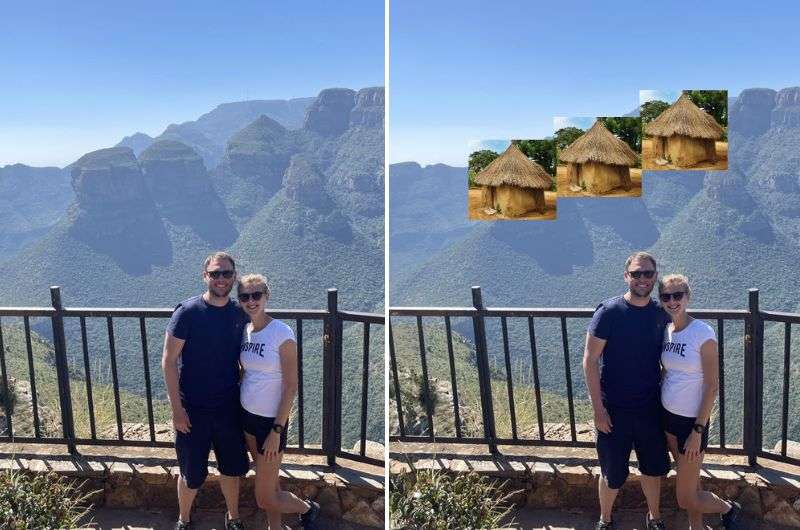
Can you see it now? @ The Three Rondavels Viewpoint on the Panorama Route
The story behind the Three Rondavels is steeped in local folklore. According to the legend, a chief lived in the Blyde River Canyon with his three wives. These wives were beautiful but fiercely jealous of each other.
One day, as the chief was away on a hunting expedition, a great snake entered the canyon and abducted the three wives, turning them into stone formations. They are now named after the traditional African dwelling that they resemble. Or something like that.
The Three Rondavels is easy peasy to reach; it’s literally a few steps from the parking lot. There’s also a second viewpoint a little to the north of the Three Rondavels, with hiking trails starting close to the Blyde Canyon, A Forever Resort.
Another must-see viewpoint along the Panorama Route is God's Window, which offers breathtaking panoramic views over the surrounding mountains and plains.
Other Blyde River Canyon activities include heading down to Blyde River Dam for a boat ride or a hike (look out for hippos and crocodiles).

Blyde River Canyon is so green!
If you give yourself 2 days for the Panorama Route (here’s the itinerary I suggest), you’ll have enough time to see Blyde River Canyon from near and far. It’s proof that South Africa has some of the best natural wonders you could imagine.
Hotel tip: Little Kubu Lodge
Further reading:
- The 11 Best Things to Do on the Panorama Route in South Africa
- A 1 and 2 Day Itinerary for Driving the Panorama Route (from Hoedspruit)
3. Tsitsikamma National Park—Otter Trail and Storms River Mouth
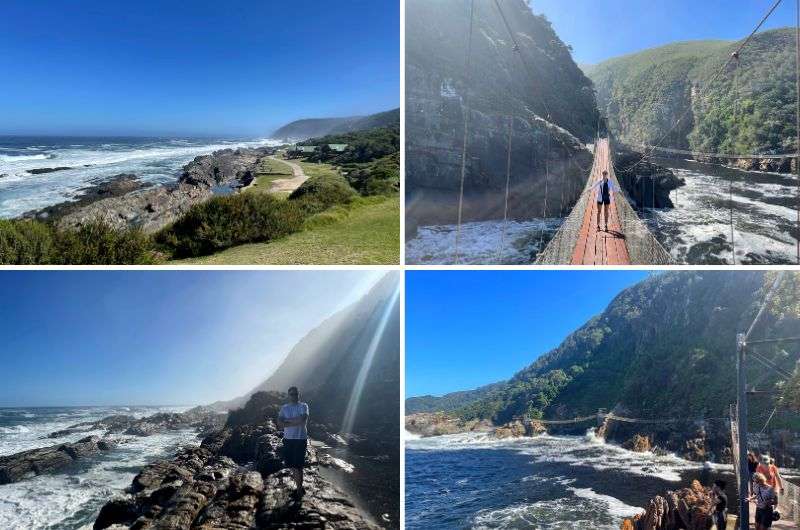
Wild nature of Storms River Mouth and Otter Trail!
Imagine a natural park rich in dense, lush forests full of wildlife, waterfalls, and rivers galore, and a dramatic, rocky coast where powerful waves pound the rocks tirelessly. All of the best hiking trails you’ll ever get to experience, and some dolphins and whales, and it’s really close to being too good to be true.
But nope, it’s real! Tsitsikamma National Park is, without a doubt, the most impressive part of the Garden Route. I fell head over heels for this place, and I’m known for my cold heart!
Storms River Mouth is the best part of Tsitsikamma NP, and even though it is easily accessible and very popular among tourists, you can’t deny it has a right to be one of the top nature spots in South Africa. This is not the spot to go looking for hidden gems.
You can’t miss the 3.7 km (2.3 mi) out-and-back trail that takes you over the suspension bridges that go straight across the wild waters of Storms River Mouth below and to some awesome viewpoints on the other side. Or, if you have a bit more stamina, head out on one of the kayaking trips with Untouched Adventures that go directly into the gorge (swimming and cliff jumping included).
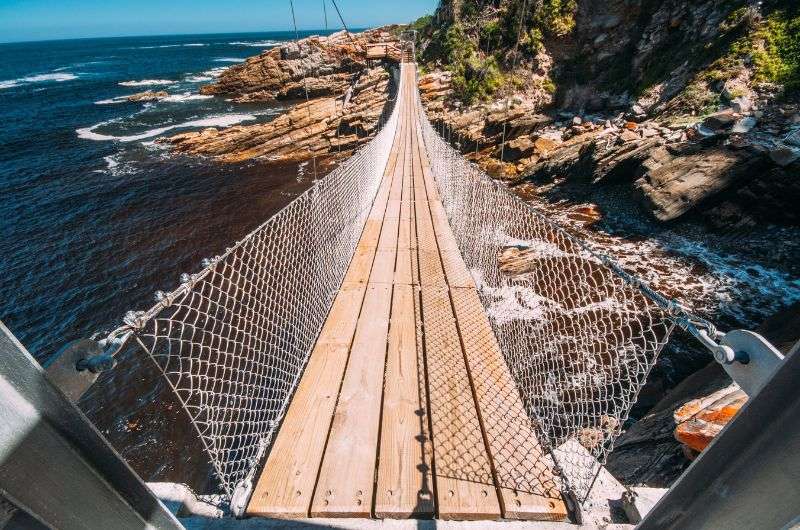
Step in for some adventure!
A few steps in the other direction and you’ll be at the start of one of the best hikes on the planet, the Otter Trail. The full hike is 5 days, which is enough to deter 90% of even the most serious nature enthusiasts.
Luckily, there’s something called the Day 1 Otter Trail: you only hike the first 4.8 km (3 mi) of the Otter Trail and then head back once you reach the waterfall. It’s a pretty technical trail, because you’re on rocks and boulders most of the way, but who doesn’t love some shoreline scrambling?? You’re so close to those waves crashing into the rocks that you’ll literally taste the salt in the air. All I can say is: Mordor vibes!
Hotel tip: Kambaku at Sea
Further reading:
- 14 Things to Do on South Africa’s Garden Route: An Unmissable Guide to the Top Attractions
- 9 Epic Hiking Trails on the Garden Route for Day Hikes
- Best Garden Route Itinerary for 10 Days: Driving from Cape Town to Port Elizabeth
- 5 Day Garden Route Itinerary (with Addo Elephant Park)
4. Table Mountain
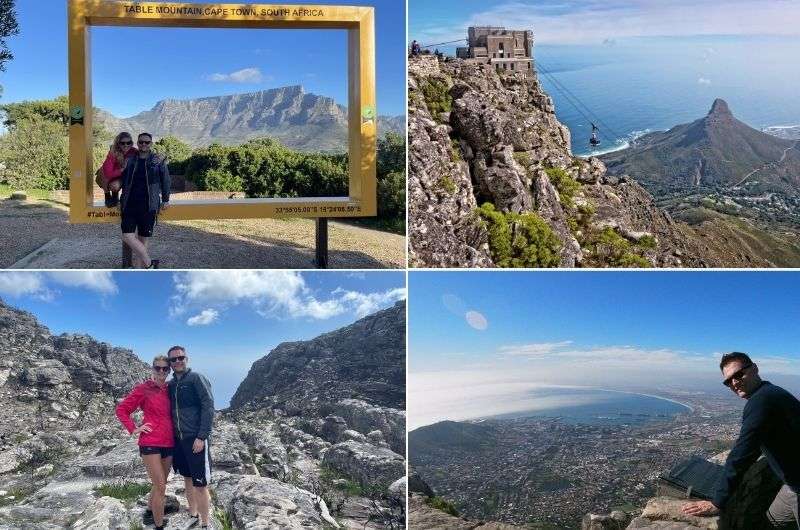
Cape Town’s biggest natural pride—Table Mountain
Could you imagine Cape Town without Table Mountain? It would be like a penguin without its tuxedo, or a coffee shop with decaffeinated coffee—simply absurd and missing the point! It’s such an iconic feature of the city that it’s front and central on its flag and part of its logo.
Table Mountain is one of the top natural places I’ve ever been to, anywhere on the planet. I don’t think anyone ever visits Table Mountain and says it’s “just ok”; you’re basically guaranteed to be blown away.
It’s not only one of the oldest mountains in the world: compared to the Himalayas, it’s 6 times older and it’s 4x older than the Alps, but it’s also incredibly rich in plant and animal species. In fact, it’s so diverse that there is the same number of plant species on Table Mountain as in the entire United Kingdom. And many of those are endemic to these mountains.
And it’s not just weird plants you’ll see on Table Mountain, it’s also quite the zoo out there—you may spot snakes, lizards, various birds, dassies, rock hyrax, and even the rare and endemic Table Mountain ghost frog.
Another “thing” you’ll almost certainly see is the tablecloth of clouds that Table Mountain is famous for. Every time the southeastern winds blow from the coast, thick clouds form all over the slopes. I must say it feels magical being there, and that’s something coming from me.
Visiting Table Mountain is as simple as a cable car ride up, or as hard as one of the roughly 200 hiking trails. There is something for everyone on Table Mountain, and if you’re not made of sugar, it’s always the right time to go.
Granted, summers could bring wind and winters almost guarantee rain, but then you also get fewer crowds, which is always a plus in my book. If you’re looking for perfect weather, choose spring or fall. But definitely GO!
Hotel tip: Home Suite Hotels Station House | DysArt Boutique Hotel
Further reading:
- 12 Best One-Day Hikes in South Africa of All Difficulties
- Table Mountain, South Africa: 9 Facts You Need to Know
- 20 Best Things to Do in Cape Town
5. Kruger National Park
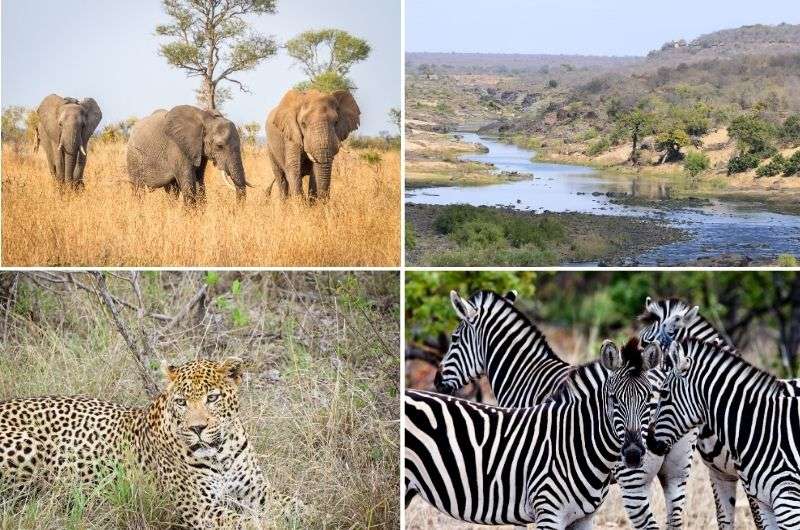
Welcome to the wild Kruger National Park!
One natural attraction that you can’t miss in South Africa is undoubtedly the safaris. Now, let me be honest—I'm not typically a "safari person." The predictability of it all tends to leave me yawning. But Kruger? Well, it's a whole different ballgame.
This place, thanks to its jaw-dropping diversity, will keep even the pickiest of travelers (yes, like me) engaged for days on end. My original plan of a modest 2-day visit. It somehow morphed into an exhilarating 4-day Kruger adventure!
Kruger NP is HUGE, almost the size of Israel! And the animals, though plentiful year-round, like to play hard-to-get. You’ll want to choose one section of the park and stick with it—the south is the best and undoubtedly most popular part of Kruger.
The driving is slow and the distances are long, but if you spot a giraffe or a family of elephants, time almost stops! We had the best luck on our early morning drives, managing to trail a group of lions and seeing some hyenas… It’s surreal being so close to these cool animals, and you won’t know how strong an experience it will be until you live it in person. Epic!
In total, there are about 150 species of mammals in Kruger, including the Big Five (though I left without a rhino sighting on my last visit). Give yourself flexibility and enough days in Kruger to go out and explore during early mornings, evenings, and everything in between to get the best chance of seeing a wide variety of wildlife.
You can self-drive in Kruger or go with a guided tour (or have a guide come with you!).
Hotel tip: Ndhula Luxury Tented Lodge
Further reading:
- A Big Kruger National Park Travel Guide: 30 Facts, FAQs, and Tips for Planning Your Own Kruger Visit
- 18 Top Tips for the Best Wildlife Sightings in Kruger National Park
6. Drakensberg–Tugela Falls and Cathedral Peak
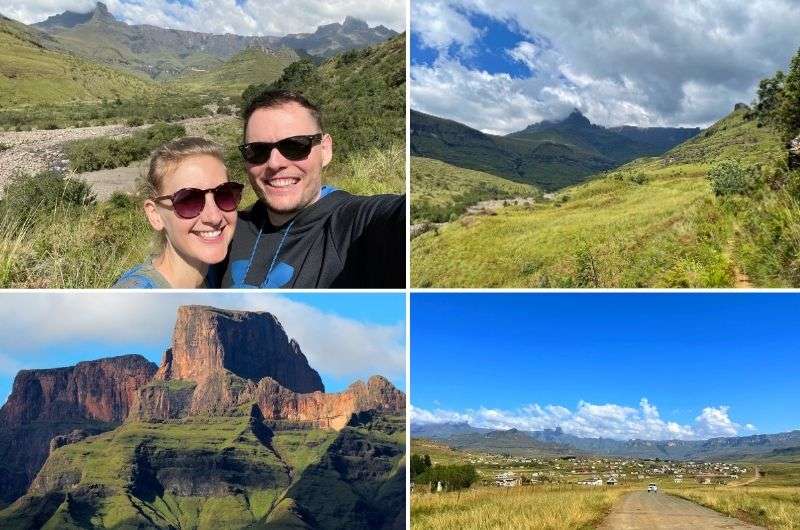
The nature of the Drakensberg
Located in the province of KwaZulu-Natal, the Drakensberg Mountains are a must-see destination in South Africa. The Drakensberg is recognized as a UNESCO World Heritage Site for both its breathtaking natural beauty and its rich cultural significance.
The region is also home to ancient San rock art, offering a unique window into indigenous traditions and the area's deep history.
For Drakensberg, more than any other natural attraction in South Africa, I feel like a picture is worth a thousand words, so I’ll add plenty of them for your viewing pleasure. These mountains are so incredible, mysterious, beautiful… they command respect and make you take more photos that you’ll be willing to sift through when you get home.
If I were to choose my favorite area of the Drakensberg, it would be Royal Natal National Park. It’s home to the Amphitheatre, one of the most impressive cliff faces on the planet, which is in turn the home of Tugela Falls, the tallest waterfall in the world (well, maybe… depending on what criteria you use—read about how Angel Falls took second place).
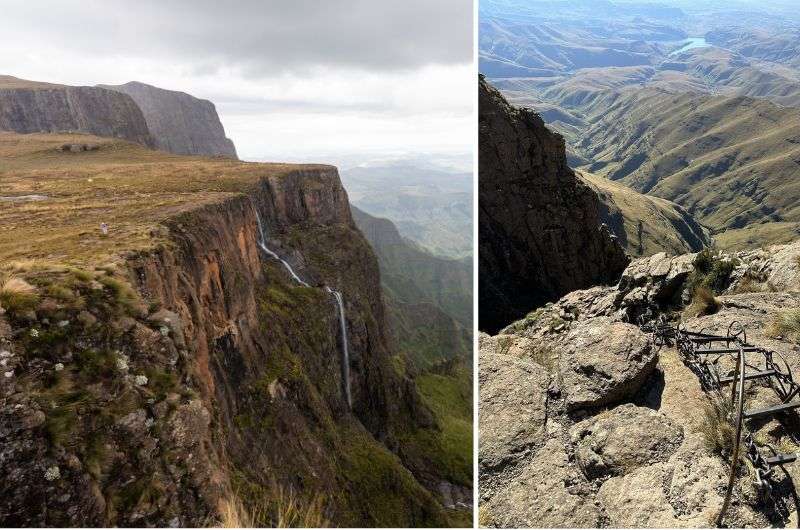
The top of the falls can be reached by a slightly scary metal ladder
You can set out on a hike to the top of Tugela Falls, which is in one word >epic<, and not just because of the hair-raising ladders you need to climb before you get to the very top. Just make sure you go in March or April, otherwise you’re not guaranteed a waterfall at all.
If you like to stay closer to the Earth, Tugela Gorge serves up incredibly picturesque scenery without the vertigo:
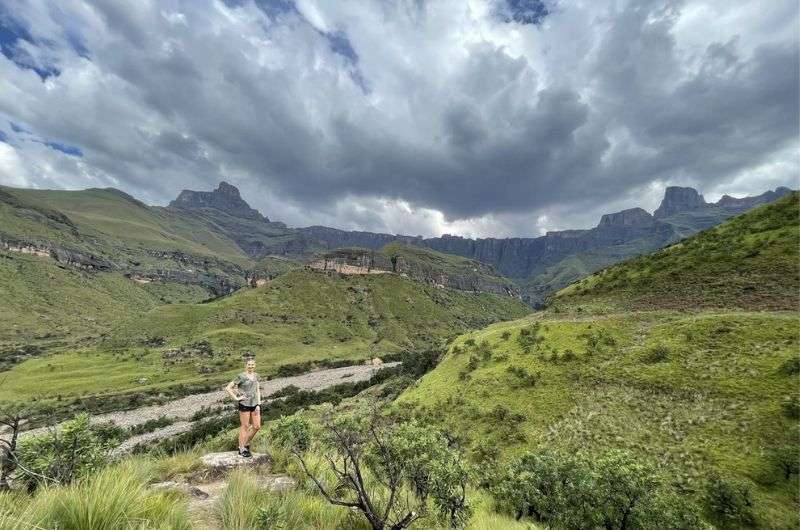
Hiking Tugela Gorge with the Amphitheatre in the background
Another insanely memorable natural landmark in Drakensberg is Cathedral Peak, a 3,000 m (9,850 ft) high free-standing mountain that’s somewhat of a symbol of the region. Since hiking to the summit is very hard and takes all day, it’s not something a lot of people will set out to do. You can, however, do the next best thing, which is to go on other hikes that have views of Cathedral Peak instead.
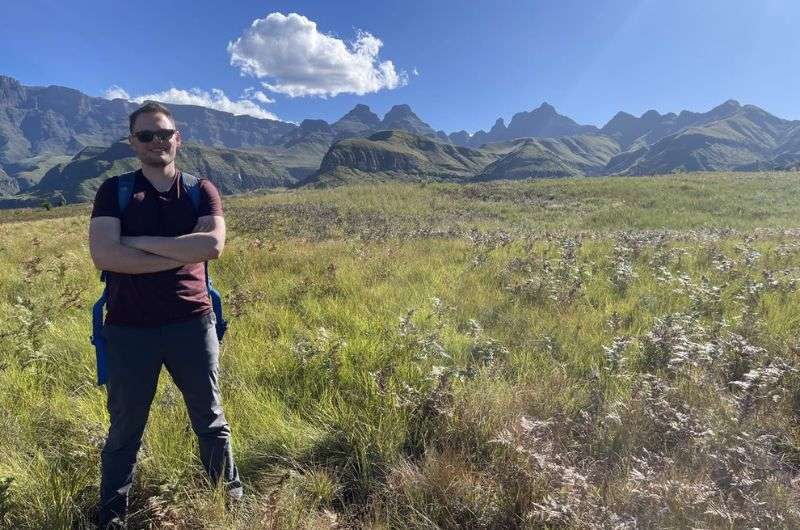
Cathedral Peak in the background on the Baboon Rock trail
Baboon Rock Trail and Rainbow Gorge are two of the hikes I personally loved in Drakensberg that also happen to have some of the best views of Cathedral Peak.
You can read full hike-planning details about the trails mentioned in this section in my article about hiking in the Drakensberg.
Hotel tip: Cathedral Peak Hotel
Further reading:
- Hiking in the Drakensberg: 9 Best Trails For Day Hikes
- 12 Best One-Day Hikes in South Africa of All Difficulties
- 7 Unique Places to Visit in South Africa
7. Lion’s Head

A lion guarding the city of Cape Town (you need a big dose of imagination)
Lion's Head in Cape Town is not a place where you'll find a pride of lions having a board meeting, despite the name! You’ll need to use your imagination to see why it got its name, but it's still one of South Africa's natural wonders that will make your jaw drop—no kidding.
Imagine a rocky peak standing proudly, like a guardian (or a lion!), over the city of Cape Town. They call it Lion's Head because, from afar, it kinda looks like a majestic lion, lying on its stomach, staring at Table Mountain.
What is now Signal Hill used to be known as Lion’s Rump—you should be able to see the whole lion armed with that information. It is part of Table Mountain National Park.
But we’re not going to be content with just looking at Lion’s Head from afar, obviously. You can (and should) hike up to the top for some of the most incredible views in South Africa! The trail is almost 5 km (3 mi) long and spirals around the mountain, making sure the views keep changing.
Once you reach the rock face at the top, you can add some adrenaline into the mix by taking the metal ladders and staples. If you’re not feeling up for it, there’s a path you can use to walk around the exciting section. The Lion’s Head hike is a popular one, because it’s such a good workout, but also a natural wonder in one!
People love climbing up in the dark so they catch the sunrise on top… I wouldn’t know, because that’s not my jam, but I can imagine it could be quite the experience. But the sunset’s not too shabby, either!
Picture this: the sun painting the sky with fiery colors as it dips below the Atlantic Ocean, the sprawling city of Cape Town at your feet, and the iconic Table Mountain keeping you company across the way. It's like getting a high-five from nature itself.
As a bonus, you'll find yourself surrounded by the vibrant flora of the Cape Floral Kingdom, which is like Mother Nature's art gallery.
8. Bourke’s Luck Potholes
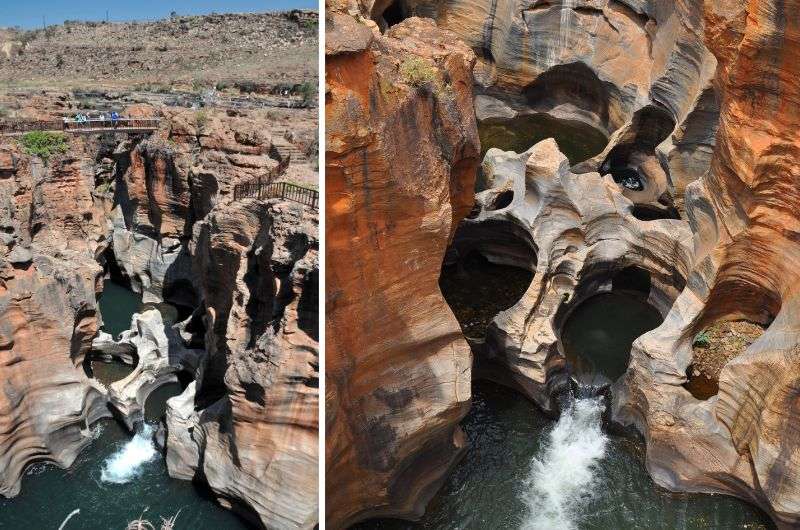
Bourke’s Luck Potholes are a magnificent natural wonder of the Panorama Route
What I like about South Africa’s natural attractions is that there’s something for everyone and that some of these spots require little effort to see. Though I do love my hikes (here are the best ones I’ve found in South Africa), I don’t need to conquer a mountain or go on a deep jungle exploration every single day.
Bourke’s Potholes is one of the natural spots that you can see in South Africa, where you just rock up to and let yourself be amazed. It’s a great bang for your buck!
Burke’s Luck Potholes is part of the Panorama Route in the northeast of the country. It’s a series of cylindrical rock formations formed by centuries of the river water swirling away. The force of the water, coupled with abrasive sand and rocks, carved these magnificent potholes into the bedrock. You can walk along the wooden walkways and bridges to stare at the potholes from all angles.
Quick and easy, we spent about an hour admiring the views at Bourke’s Luck Potholes.
Hotel tip: Little Kubu Lodge
Further reading:
- The 11 Best Things to Do on the Panorama Route in South Africa
- A 1 and 2 Day Itinerary for Driving the Panorama Route (from Hoedspruit)
9. Kirstenbosch National Botanical Gardens
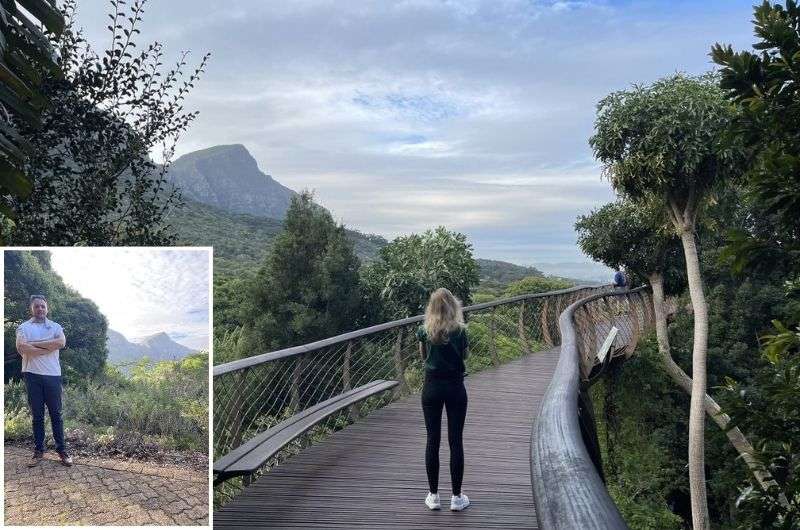
The “Boomslang” bridge and the incredible views from Kirstenbosch National Botanical Garden
Each time I step into this gem of a park, it's like a slap of beauty right across the face. I mean, seriously, how does Kirstenbosch Botanical Garden manage to keep getting more stunning? Sitting at the foot of Cape Town’s Table Mountain, it’s not just the flora you’ll be admiring, it’s the overall views of the stunning nature all around you. It’s like Kirstenbosch is a nature fairy that keeps giving!
I—the snake-lover that I am—am always on the lookout for the resident snakes, especially the Cape Cobra, which goes by the oh-so-funny name Nivea in Latin. And don't even get me started on the views from the Boomslang—the super cool bridge that snakes its way through the treetops.
As for time spent, well, I can hang out anywhere from 1 to 5 hours, depending on whether I decide to conquer every nook and cranny and try to discover a new plant to name after me (I like the ring of “Janus Travelus Epicus”) or just take a quick walk. Plus, let's not forget, one of the grand entrances to Table Mountain begins right here.
Hotel tip: Home Suite Hotels Station House | DysArt Boutique Hotel
Further reading:
- 5 Things to do in Cape of Good Hope
- 12 Best One-Day Hikes in South Africa of All Difficulties
- Best luxury and boutique hotels in Cape Town
10. Wilderness National Park
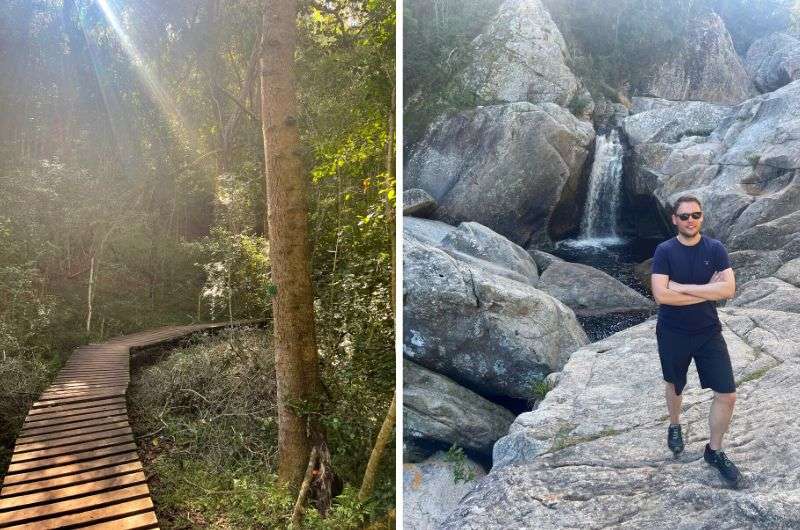
My favorite part of Wilderness National Park—Half-Collared Kingfisher Trail
Wilderness National Park is just one of three sections of the wider Garden Route National Park. It’s the area around Wilderness, George, Sedgefield, and Knysna.
For me, the highlight of Wilderness is the Half-Collared Kingfisher Trail, an easy hike (more of a walk) under a canopy of trees, partially on a wooden walkway, with a pontoon bridge that kickstarts the fun section of the trail after a semi-boring 15-minute beginning. There’s also a smallish waterfall at the end that is nice, but the 1-hour journey to get there is way nicer.
We hit the Vervet monkey jackpot on the Half-Collared Kingfisher Trail, too—those cheeky little devils almost swiped our phones!

Another perspective of South African nature—from the water!
Another cool activity in the Wilderness that brings you close to nature is canoeing. You get a different perspective on your surroundings when you’re looking at them from the water, plus, there are so many birds!
My partner turned our canoe into a wobbly seesaw, learning her paddling skills on the spot. This led to an unforgettable, hour-long adventure that felt like a survival showdown against the gentle river's slow current.
If you’re more adept at paddling, you could also choose some more advanced routes: you can paddle out to Island Lake for a 3-hour round trip, or choose the slightly more exciting trip to the river mouth for a maximum 1.5 hours round trip.
It’s also possible to canoe part of the Half-Collared Kingfisher Trail and hike the rest, which could be the sweet spot if you can’t decide which activity is best for you.
Hotel tip: Kambaku at Sea
Further reading:
- 14 Things to Do on South Africa’s Garden Route: An Unmissable Guide to the Top Attractions
- 9 Epic Hiking Trails on the Garden Route for Day Hikes
- Best Garden Route Itinerary for 10 Days: Driving from Cape Town to Port Elizabeth
- 5 Day Garden Route Itinerary (with Addo Elephant Park)
11. Waterfalls on the Panorama Route

My top 3 waterfalls on the Panorama Route
This is a waterfall-bundle situation—there are numerous waterfalls on the Panorama Route that are worth stopping at. Considering how easy they are to get to, you’d be foolish not to go.
Some are just a 5-minute walk from the parking lot, some require you to go on an hour-long educational trail (loved it!), and all of them are ready for tourists. Add all the other pretty stops on the route, and you’ve got yourself a stellar scenic drive with all these natural wonders sprinkled down it.
My three favorite waterfalls on the Panorama Route are:
- Lisbon Falls: This place has it all–a picturesque waterfall with a dramatic backdrop, a great viewpoint, and a chance to hike down to the falls' base. Lisbon Falls is a short walk from the parking lot, but if you can handle more than a few steps, I seriously urge you to make the 20-minute trek down to the base. The view from the bottom is absolutely mind-blowing, and you can take a dip in the pool there, too.
- Motitsi Waterfalls in Graskop Gorge: Don’t miss the chance to visit Graskop Gorge—a natural wonder that has been upgraded by human hands and built up into an adrenaline and educational hub (think elevator that takes you down into the gorge). Not only did I see the waterfalls on my thrilling zipline ride, but my favorite part was the gorgeous 1-hour-long Afromontane forest walk that took us straight to the waterfall’s base. Stunning!
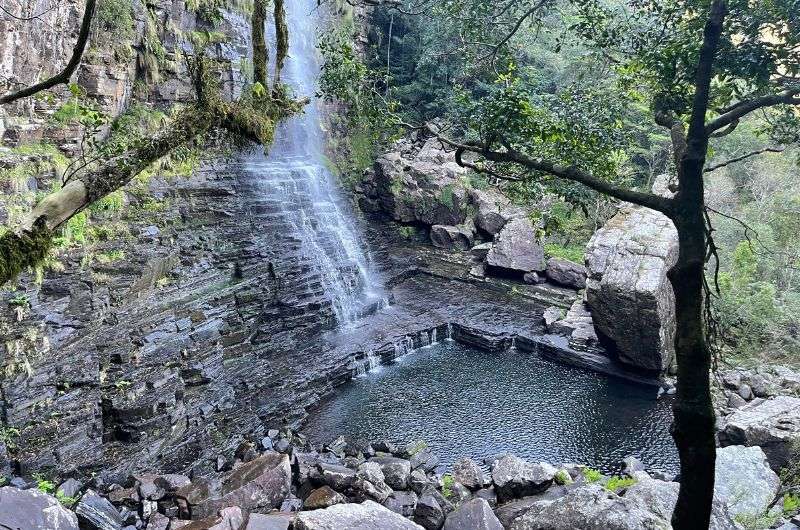
Simply amazing!
- Mac Mac Falls: Mac Mac Falls are twin waterfalls that plunge an impressive 70 m (230 ft). The trail leading to the viewing platform and the series of pools is worth mentioning; the gorge views were spectacular (even though it was a very short walk). The viewing platform here is a bit obstructive and crowded, but it’s worth it anyway. You can walk down to the base of the falls, too.
If you can’t get enough water falling down from the rocks, there’s also Berlin Falls (supposedly the tallest in the area, but we caught it with less water than we would’ve liked) and Sabie Falls (has potential, but is a little neglected).
Hotel tip: Little Kubu Lodge
Further reading:
- The 11 Best Things to Do on the Panorama Route in South Africa
- A 1 and 2 Day Itinerary for Driving the Panorama Route (from Hoedspruit)
12. Sudwala Caves
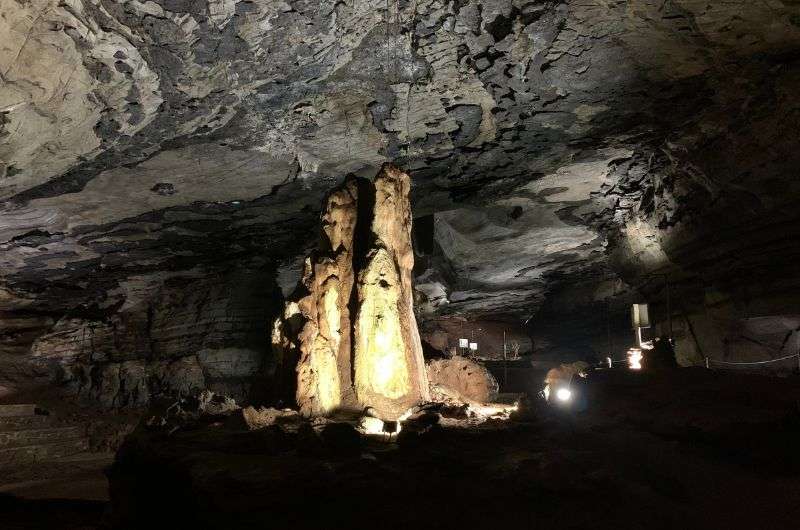
The oldest caves in the world
For this next natural wonder, you’ll need to head to the Panorama Route and then underground. The Sudwala Caves are the oldest (known) caves in the world. And guess what? They are as fascinating as they sound. Usually, when you go see caves in Europe, they are babies—only up to a million years old—that’s nothing in Earth years. But the Sudwala Caves are over 200 million years old!
Let me tell you, those stalactites and stalagmites had me mesmerized. But the real showstopper here is the stromatolites. These bad boys played a crucial role in the Great Planet Oxidation and the rise of complex life on Earth.
If you have no idea what that means, don’t worry; even just looking at the shapes and size of the creations down in the caves is cool enough. You can go on a 45-minute tour, and if you’re lucky like us, you’ll get a fantastic guide that had all the answers to my tricky questions.
If you take caves seriously, you can even set out on the 4-hour Crystal Tour—we’re talking getting down and dirty, headlamps and all. Warning: The cave tours go through narrow areas, so if you are claustrophobic or can’t fit your booty into narrow areas, maybe skip this natural attraction.
Hotel tip: Little Kubu Lodge
Further reading:
- The 11 Best Things to Do on the Panorama Route in South Africa
- A 1 and 2 Day Itinerary for Driving the Panorama Route (from Hoedspruit)
13. Cape Agulhas
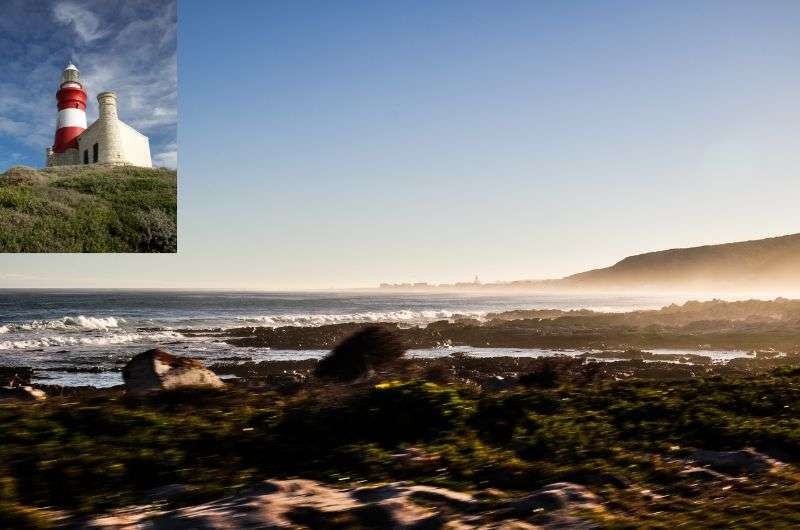
The southernmost point of Africa—Cape Agulhas
We can’t talk about the best natural attractions in South Africa without mentioning the southernmost point of the African continent. The “Southern tip of Africa” monument is located a little to the west of Cape Agulhas, so don’t miss it if you like to check places like this off your bucket list. And there’s also the Agulhas National Park to explore, after you’re done with your perfect Cape pics for Instagram.
Another reason why Cape Agulhas gets attention is that it’s where the Atlantic and Indian Oceans meet. The water here is also pretty shallow, making it popular with fishermen. I can just imagine them wondering which ocean their dinner will come from on any given day.
The area closest to the cape is very rocky, with extremely high waves in the winters—up to 30 m (100 ft) high!—hence the shipwrecks the coast is littered with.
It may come as a welcome surprise, then, that just around the corner from Cape Agulhas (to the east) are some of the most beautiful beaches in South Africa. There is an almost endless line of soft, powdery beaches, starting with Struisbaai Beach.
They are wide, with large, unspoiled sand dunes and kilometers of beach that you’ll probably have all to yourself (minus the occasional group of horse riders), perfect for long walks and tiring the kids out or having a romantic frolic in the sand with your significant other.
This post contains affiliate links. I earn a small commission if you make bookings through my links, at no additional cost to you. This helps keep this blog free, thank you!


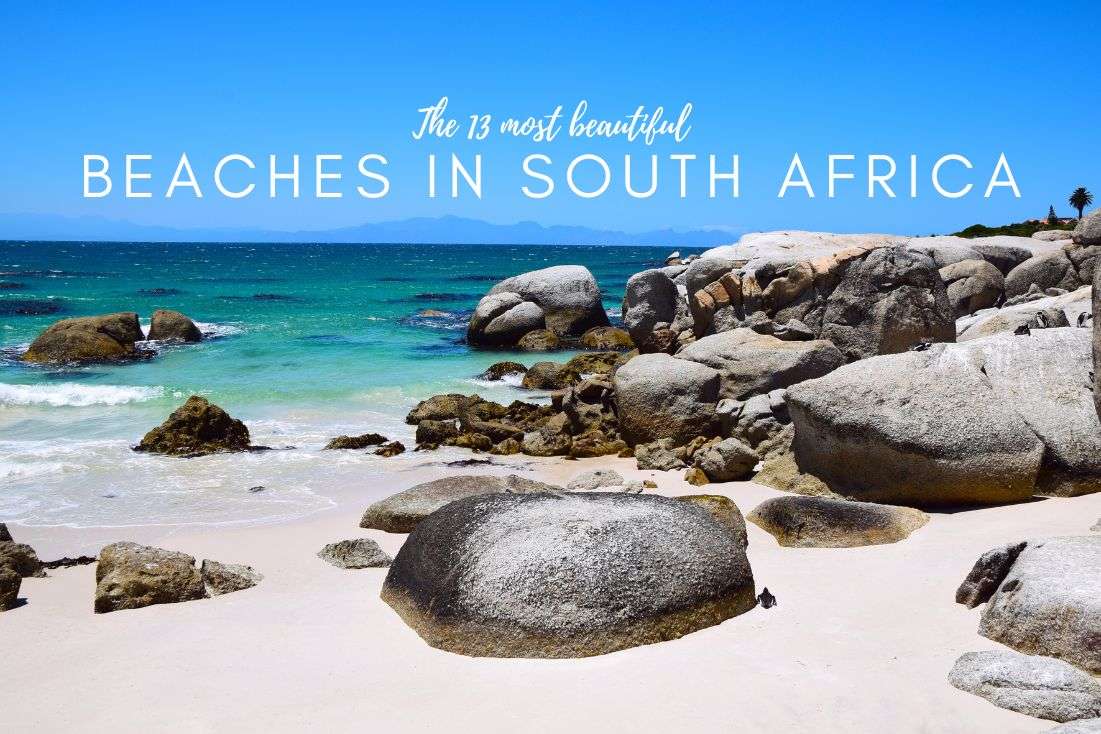
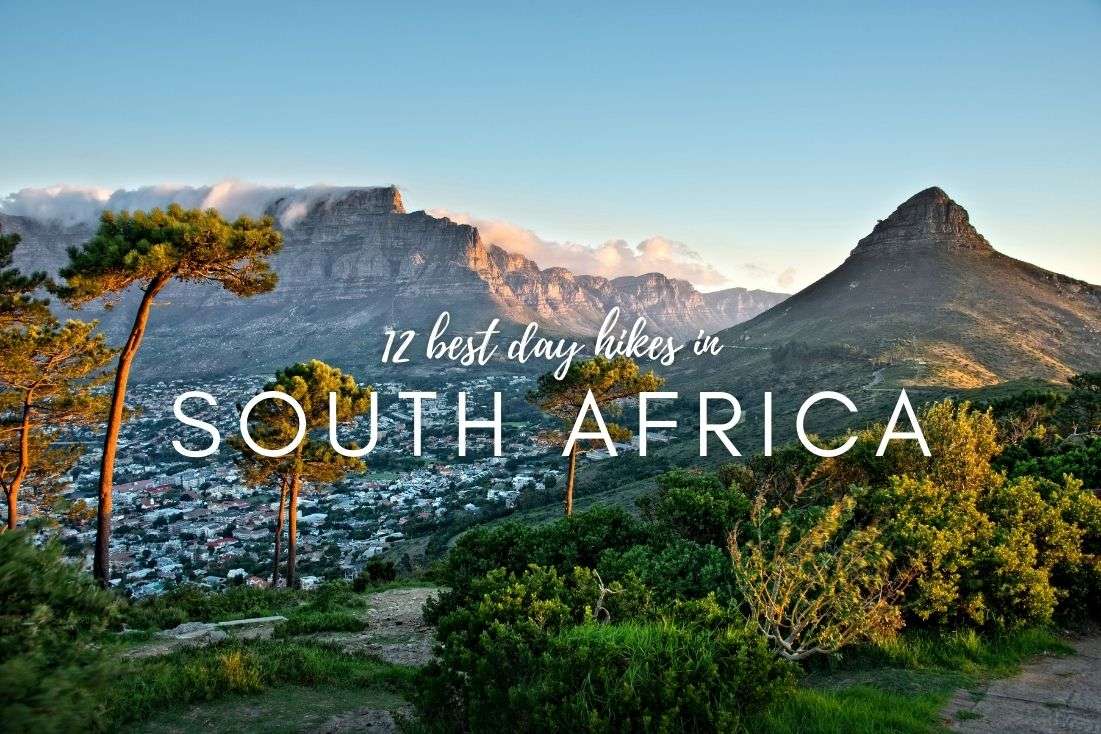
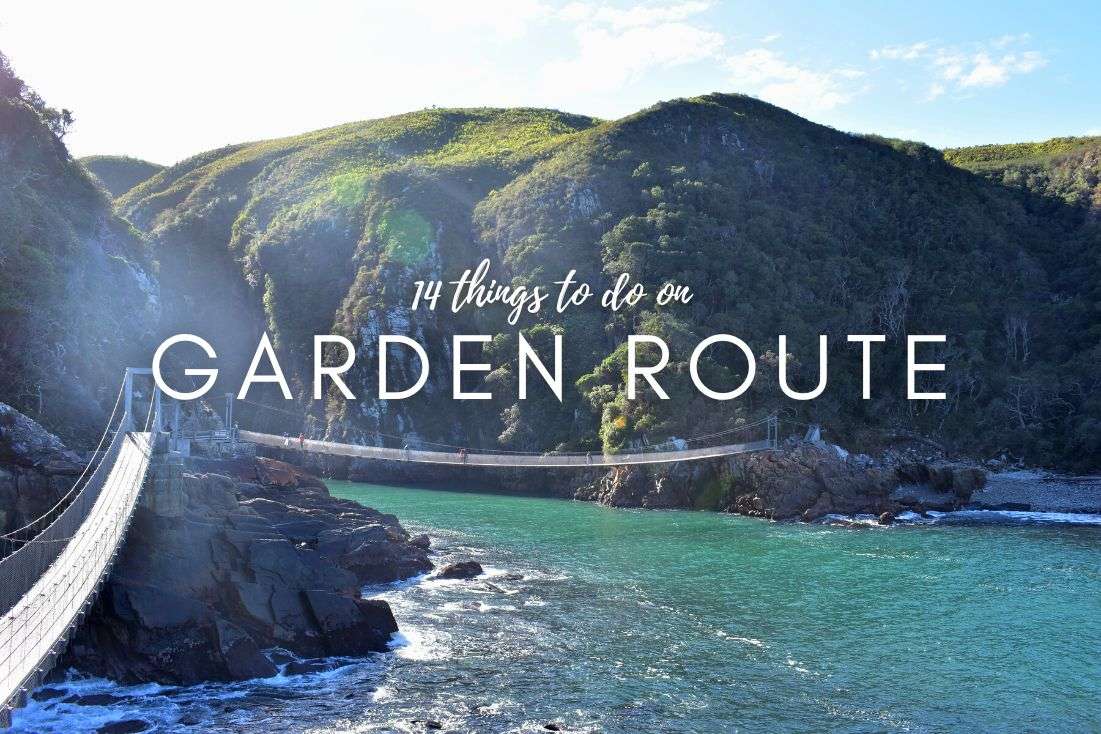





Comments | Thoughts? Give us a shout!